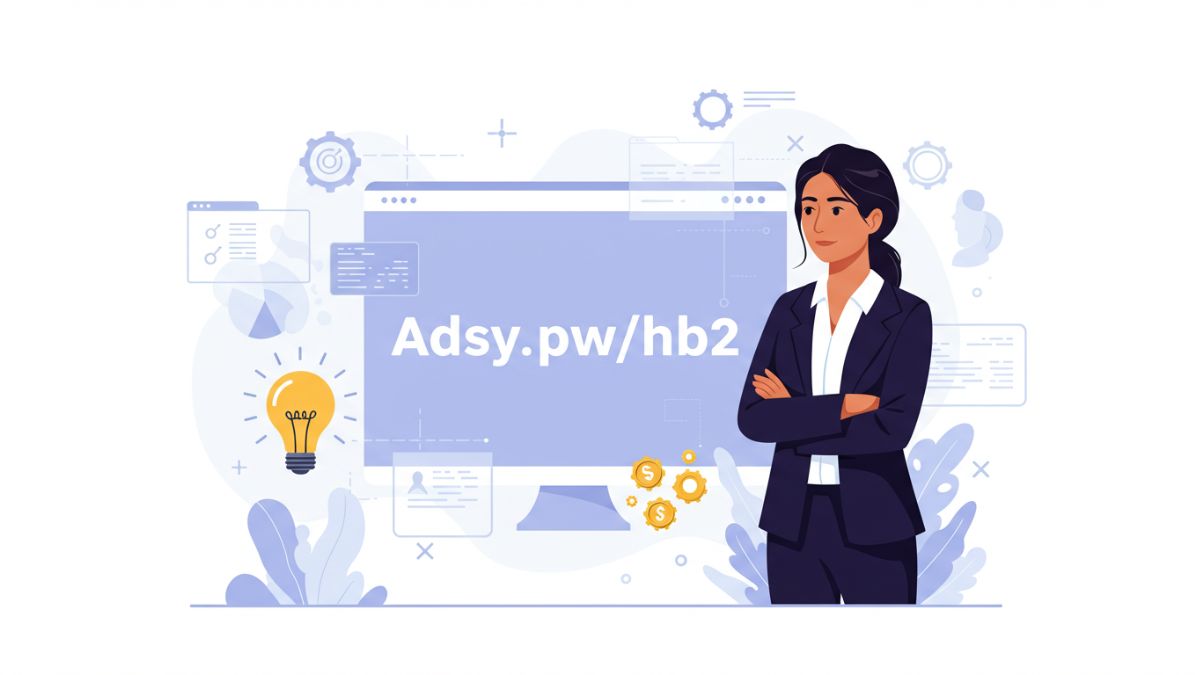In the vast and intricate world of the internet, where billions of pages are interlinked by trillions of URLs, every so often a single link emerges that raises more questions than answers. One such link is adsy.pw/hb2—a shortened URL that, despite its minimal form, has sparked intrigue, confusion, and a surprising level of online attention. It may appear insignificant at first glance, but its ambiguity and lack of context have made it the subject of speculation across tech forums, social media platforms, and among digital culture observers.
So, what is adsy.pw/hb2? Is it part of a marketing campaign? A remnant of an abandoned project? A harmless redirect, or something more deliberate—perhaps even hidden? In this article, we explore the technical foundation, potential origins, cultural interpretations, and broader implications of this curious shortlink in the ever-evolving digital ecosystem.
The Anatomy of a Shortlink
To understand adsy.pw/hb2, it’s important to first examine how URL shorteners work. A shortened URL is a compact version of a longer web address, typically created for convenience, tracking, or space efficiency—especially on platforms where character count is limited (like Twitter/X).
Here’s how it works:
-
A user inputs a long URL into a shortening service (like Bit.ly or TinyURL).
-
The service generates a unique suffix—usually a few alphanumeric characters (like “hb2”).
-
The resulting shortlink (e.g., adsy.pw/hb2) becomes a redirect gateway, leading to the original long URL when clicked.
These services are widely used by:
-
Marketers, to track campaign engagement
-
Developers, for API testing and internal routing
-
Social media influencers, to disguise affiliate links
-
Cybersecurity researchers, for controlled redirection tests
-
Malicious actors, to hide phishing or scam destinations
What Is adsy.pw?
The domain adsy.pw is the foundation of the link. “.pw” is the top-level domain originally designated for Palau, a small island country in the Pacific. However, it has since been marketed as the “Professional Web” TLD, and is often used for commercial or experimental projects. Its low cost and wide availability make it popular among:
-
Startups
-
Automation tools
-
URL shortener providers
-
Spam operations
-
Underground campaigns
“Adsy” suggests a possible link to advertising or ad tech, and the domain itself has been associated with multiple URL redirection tools in the past. While it is not as well-known as Bit.ly or Rebrandly, it has been used in various digital marketing scenarios and low-profile affiliate campaigns.
The Enigma of /hb2
The suffix “hb2” is particularly ambiguous. In the context of URL shortening, slugs like these can be:
-
Auto-generated (sequential or random)
-
Custom-defined by a user
-
Representations of campaign codes or tracking identifiers
The letters “hb” could theoretically stand for a multitude of things:
-
“Homebase 2”
-
“HyperBoost v2”
-
“Hidden Beacon 2”
-
Or simply be random alphanumeric text with no deeper meaning
The number “2” might suggest a second version or iteration—adding to theories that adsy.pw/hb2 could be part of a multi-phase release, test, or campaign.
The Mystery Surrounding Its Use
The primary reason adsy.pw/hb2 has gained traction is not because of what it reveals, but because of what it doesn’t. The link is often shared without any explanation—no description, no preview, and no obvious context.
Online observers have reported seeing it:
-
Embedded in obscure online forums
-
Shared in private Discord groups
-
Appearing in short-lived Twitter/X threads
-
Used as a redirect in QR codes found on posters or stickers
-
Referenced in cryptic YouTube video descriptions
This pattern has led many to ask: Why would someone repeatedly share a link with no public-facing content?
Potential Explanations
1. Abandoned or Expired Link
Shortlinks often expire or are removed by their creators. It’s possible that adsy.pw/hb2 once redirected to active content—perhaps part of a marketing campaign, event registration, or promotion—but was later deactivated. This would explain why clicking it today may lead to an error, dead-end, or blank page.
2. ARG or Digital Art Installation
Alternate Reality Games (ARGs) use hidden clues, links, and codes to create immersive online mysteries. It wouldn’t be the first time a shortlink was used as an entry point into a larger story. Projects like Cicada 3301 and indie art initiatives have used similar methods to lead users through puzzles, narratives, and digital performances.
3. Affiliate or Cloaked Redirect
The URL may have been used in affiliate marketing, where link cloaking is common. Marketers often disguise affiliate links with shortlinks to protect commissions, obscure product pages, or test user reactions to different versions. Once a campaign ends, the destination is often deleted—leaving a mysterious, unexplained stub behind.
4. Phishing or Malware Campaign
Unfortunately, shortlinks have also been used to hide malicious destinations. While no confirmed reports link adsy.pw/hb2 to malware or scams, caution is always warranted when dealing with unverified shortlinks, especially from unknown sources.
The Psychology of Curiosity
A significant part of what makes adsy.pw/hb2 so intriguing is human psychology. As information becomes more accessible and instantaneous, the unknown becomes rare and therefore captivating. A nameless link with no preview challenges the modern internet user’s expectations of transparency and familiarity.
In this context, adsy.pw/hb2 represents more than just a link:
-
It’s a symbol of digital mystery
-
A provocation for internet detectives
-
A neutral canvas onto which we project speculation, theory, and narrative
The phenomenon mirrors past online obsessions such as:
-
The “Blue/Gold Dress” debate
-
Reddit’s u/_9MOTHER9HORSE9EYES9 user account
-
The endless search for the source of the “Screaming Cowboy” video
The Role of Anonymity in Digital Culture
Shortlinks like adsy.pw/hb2 also highlight the increasingly anonymous and fragmented nature of digital content. In many cases, authorship is hidden, content is ephemeral, and meaning is derived through community interpretation rather than authority. This is a reflection of the decentralized, memetic internet where meaning is shaped collaboratively.
Implications for Cybersecurity
From a cybersecurity perspective, adsy.pw/hb2 also reminds us of the risks that shortlinks pose:
-
They can bypass firewalls or filters that detect suspicious URLs.
-
They can track users without their consent.
-
They often obscure real destinations, making it hard to identify threats.
Security professionals recommend using tools like CheckShortURL, URLExpand, or VirusTotal to preview or scan any suspicious link before clicking.
What We Know Today
As of writing, adsy.pw/hb2 leads to either:
-
A dead or inactive page
-
A redirect loop that ends in error
-
Or content that has since been removed or taken offline
This only adds to the intrigue, as users wonder what once lived behind the link—and why it was removed without a trace.
Conclusion: The Digital Ghost of a Forgotten Link
In a world where attention is currency and mystery is rare, adsy.pw/hb2 has become an unlikely artifact of digital curiosity. Whether it was a forgotten test, an ARG clue, an expired ad campaign, or just a throwaway redirect, it has taken on a life of its own—precisely because it doesn’t explain itself.
In this way, adsy.pw/hb2 is not just a URL. It’s a window into internet culture: where the simplest elements can become puzzles, and where every digital trace—however brief—has the potential to become a legend.

